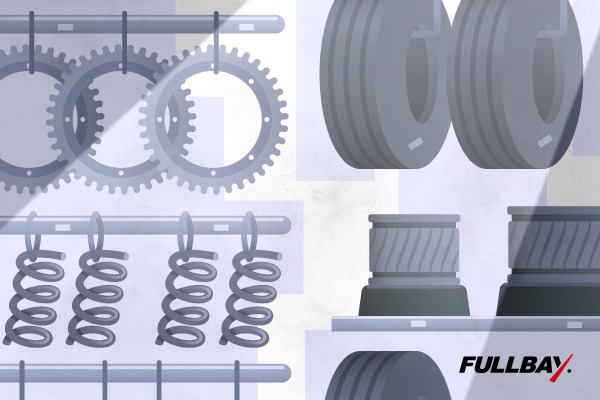Your Guide to Maximizing ‘Core’ Business

Part cores. They’re dirty. They can seem hard to track. But do not fear them. At the end of the day, cores are just like any other part: you buy them, sell them, they can go obsolete, and can vanish if you don’t carefully track them.
And believe us, you do want to track them.
We’ve written extensively about how to secure more business during your shop’s downtime. Tracking core parts and returning them to manufacturers for refurbishing is another way to do that. A refurbished part is often less expensive than a brand-new part; fleet managers and truck owners who want to save some money will often look to replace broken or worn-out parts with refurbished versions rather than kick out cash for their newer iterations.
If you want to move the needle on shop profitability, recycling core parts is the way to do it. We’ve put together this guide to help you do it.
The Nitty-Gritty of Part Cores
What are part cores?
At the most basic level, a core is just a used part. A vendor may sell you a part with a “core charge” attached to it; they will refund you the cost of that charge when you return the part to them after it wears out or is replaced. At a very basic level, you can compare it to a 5-cent recycling fee attached to glass bottles; when you finish with the bottle and bring it to a recycling center, they provide you with that 5 cents.
This bounty – which, by the way, is usually way larger than 5 cents in the heavy-duty world – is an incentive for you to return the core to them to be either recycled or reconditioned; it’s often called a “core charge” or “core deposit.” Batteries are a classic example; in fact, core charges on batteries are required by law in over 30 states.
With that said, just because a used part has value doesn’t mean the vendor will assess a core charge. Tire casings are a classic example of this. In the commercial tire world, tires can be retreaded many times. The “core” of a tire is referred to as a tire casing. But it’s really just a core. Even though vendors don’t typically assess a charge on tire casings, you should still be tracking these like any other core. That’s because tire casings have value after their original application.
Inherent Cores vs. Dirty Cores
There are two types of part cores: inherent and dirty. When you first buy a part, there is a core “inherent” to that part (because it’s inseparable from the part itself). That is the inherent core. The inherent core is sometimes referred to as the “clean core.”
In contrast, the dirty core is the actual used part removed from the truck or equipment. A core charge is technically for the inherent core. But as explained above, at the end of the day it’s really just an enticement to return the dirty core.
Building a Core Revenue Income Stream
Okay – the what and the why of core parts out of the way. Let’s get down to the cool part: generating some side revenue with those core parts. Everyone’s business plan will look a little different, but we’ve outlined five steps to take to boost your core business.
1. Determine which parts you want to track
Sure, you can track everything. But odds are certain parts will be of greater value to you than others, based on the bounty they fetch, how frequently you see them, and what you pay your technicians, among other things.
2. Determine how to track them
These parts are now revenue for you, and you’ll want to track them like any other part. You can do this the old-fashioned way with pen and paper, or jump into some spreadsheets, or find some software that will do it for you. We’ve heard Fullbay is really good at this – wink wink, nudge nudge.
3. Find a place for them
What did you do with your dirty cores before? If you shoved them into a basket or a back room and forgot about them, then it’s time to change your ways. As we said, these parts are now dollar signs for your shop. Cores need their own visible, secured area. This is often in the parts room, where the parts manager can count and control them. In the parts room they enjoy the same physical protections against theft as the rest of the parts. They should never be “out of sight, out of mind.”
4. Return them on time
There’s likely a temptation to just let the parts sit until you have a moment to get them shipped to the manufacturer or vendor. Resist that temptation. The longer you keep the dirty cores just lying around, the more their value may drop, and besides, that’s just money sitting in your parts room. Set up a regular schedule for returning parts and stick to it.
5. Remind your employees there’s money in it
If your techs don’t immediately recognize old cores as potential income, it’s up to you to change their thinking. A lot of this new line of business is up to them; they’re the ones taking out the core parts and storing them/logging them in.
The Process of Core Accounting
It’s critical to distinguish between inherent cores and dirty cores – why? Because there are at least five points where you could lose track of part cores:
- Purchasing parts
- Receiving parts into inventory
- Selling parts
- Giving customers credit for part cores
- Returning dirty cores to the vendor
1. Purchasing parts
When you purchase parts, the vendor will charge you for the parts and for the inherent core. Track each of these costs separately – if you lump the two charges together, you’ve already lost track of the core!
2. Receiving parts into inventory
When you receive parts into inventory, you need to track the part and the inherent core separately. That means separate line items on the inventory listing for the part and the inherent core.
This is because their costs could change independently from time to time; for example, today a battery may be $150 with a $40 core charge. But tomorrow it could be $165 with a $50 core. If you don’t separate the two, you won’t have a good idea of what to charge the customer for the inherent core.
3. Selling parts
When you sell a part with a core, there should actually be three lines on the invoice:
- A charge for the part itself
- A charge for the inherent core
- A credit for the dirty core
If the customer returns the dirty core immediately, it makes sense to give them credit for it right on the invoice. If the core is returnable but in poor condition, you’ll reduce the credit amount accordingly. And if they don’t give you the dirty core immediately, you’ll remove the credit completely.
Why three separate lines? You need to still track the fact that you sold the inherent core along with the part. And you also need to track that you took a dirty core into your possession (more on that below).
Here’s An Example
Let’s say you sell a battery for $200, with a core charge of $50. You would show the following on the invoice:
- Battery: $200
- Core charge: $50
- Core credit: -$50
The net amount charged to the customer, if they immediately return the dirty core in good condition, is still only $200. This is because the core charge and the core credit offset each other.
Now let’s say the customer gives you the dirty core, but it’s in poor condition. You assess it to be worth half what a core in good condition would be, so you reduce the core credit to $25. The invoice would look like this:
- Battery: $200
- Core charge: $50
- Core credit: -$25
The net amount charged to the customer would be $225.
Finally, if the customer didn’t return the dirty core immediately, the invoice would look like this:
- Battery: $200
- Core charge: $50
You would charge the customer $250 because there is no credit at all for the dirty core. If they return the dirty core, you can give them a separate credit or refund at that time.
4. Giving customers credit for part cores
As soon as you remove a dirty core from a truck, you should inspect and, if possible, assign it a value. This value determines how much credit you give to your customer against the inherent core charge. If the core is not in returnable condition, or if the vendor will only give you partial credit, make sure you deduct that amount from the dirty core credit before you invoice the customer for the repair.
If you aren’t sure what value the vendor will give for the dirty core, remove any credit for the dirty core when invoicing the customer. Once you find out what the vendor will pay for the dirty core, you can then issue the customer an appropriate credit or refund.
Regardless, when you take the dirty core from the customer and place it on the shelf in your parts room, you should enter it on your inventory listing. The dollar amount you gave the customer in the form of a core credit becomes the value of the dirty core in your inventory. If you don’t do this, you’ve lost track of the core.
5. Returning dirty cores to the vendor
If you give a customer credit for returning a dirty core, track and protect that dirty core until you return it to the vendor. The parts manager should be able to run a report at any time showing the total quantity and value of dirty cores “in stock.” And like we said above, when doing inventory counts, a shop should count cores like any other part.
By keeping track of your cores through these five potential loss points, you’ll be well on your way to generating more income.
Go Get Those Cores
Creating a “core” revenue stream (see what we did there?) may take some time to set up and deploy, but additional income never hurt anyone. Build out a new process around these types of parts and – we’re sorry for this – see your core earnings soar.

